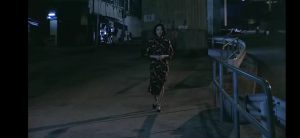Rouge DIR. Stanley Kwan (1988)
Rouge was released by Golden Harvest in 1988. Adapted from Lee Pik-Wah’s novel, the film tells a doomed romance between a courtesan Fleur (Anita Mui), and Chan Chen-Pang (Leslie-Cheung), a wealthy noble playboy. They fell in love in the 1930s, but upon realizing their love would never be accepted by Chan’s family, they committed suicide by opium and promised to meet in afterlife. 50 years later, Fleur returned as a ghost to search for her lost lover with the help of another couple. The two timelines are interspersed with flashbacks, unfolding the enormous changes throughout 50 years, both spatially and emotionally.
In the 1930s, Shek Tong Tsui was prestigious red-light area where Fleur’s brothel located. The Tai-Ping Theatre, established in 1904 at Des Voeux Road West, was also the first and biggest theatre in Hong Kong. Fleur used to enjoy the Cantonese opera there with her friends. It was demolished in the 1960s and displaced by the current Wah-Ming Centre. Along with Fleur’s nostalgic tone, the theatre was captured in flashbacks, portraiting the glorious signboard, vibrant actors, and girls’ cheerful chuckle. However, 50 years pass, nothing of the luxurious past remained, what replaced instead was a shopping mall standing silently and gloomily in thick darkness.

Tai-Ping Theatre. Scenes from the Golden Harvest’s Rouge, 1988, directed by Stanley Kwan.
I visited this old site on a sunny afternoon. Different from the 1930s’ boisterous and delightful atmosphere in the film, the current Wah-Ming Centre was a closed, lonesome site beside the noisy street. With pedestrians rushing in and out of MTR station, taxis and buses roaring, I cannot grasp any glimpse of that relaxed and leisurely atmosphere now. The old frisky and hilarious lifestyle has totally disappeared, and all are flooded by an overwhelmingly hustling, fast-paced urbanizeded life.

Wah-Ming Centre now(once Tai-Ping Theatre).
Another scene illustrated in Shek Tong Tsui was the Sai-Wan Hill Road, where Fleur lingered for days wishing that Chan would show up. It was a slope leading up to the previous brothel, which was replaced by a kindergarten in 1987. In the film, she casts her gaze, full of anticipation and passion, towards every young man who walked past, whereas only got teasing in return. Chan did not honor their promise and Fleur was heart-broken. The director utilized a gloomy and cold tonality to depict Fleur’s desperation and depression.
By contrast, the hill road nowadays in the daytime is a peaceful and quiet place, with elderly sitting beside and children running out from school.


Left: Brothel replaced by kindergarten. Right: Sai Wan Hill Road. Scenes from the Golden Harvest’s Rouge, 1988, directed by Stanley Kwan.

Sai Wan Hill Road nowadays
Moreover, Rouge touches on a deeper front. In the film, the rouge, Tai-ing Theatre, Old Brothel and the lost lover, all signified faded and irreversible “good old days”. After all, buildings, streets, even lovers can change rapidly within 50 years, so what can always remain the same? Just as Abbas1 stated, in the unprecedented urbanization and globalization, we always need to cling to something from the past to pacify our fear of the future, to quench the desperate desire for an image of identity, which, is love for Fleur in Rouge, and meaningful architecture for us now.
— Sze Lui 3035799337
Notes:
1 Ackbar Abbas, “Building on Disappearance: Hong Kong Architecture and the City,” Public Culture 6 (1994):445; 448.
I can imagine that there are a lot of differences already between the 1930s, 1988, and today. To reflect on Abbas’ disappearance/reappearance, it would be worthwhile to dig a little bit into the building’s history. What had triggered its demolition/renovation in the 1960s? What kind of space was created by this process and if (or how) it was represented in the film? In the last paragraph, you mentioned the need to hold on to a familiarity with the past. How would you think it was done through the film? Was it done at all, after all? Relating your analysis to one of the key ideas we have discussed in the class will be helpful for you to read through the site and build your argument. Lastly, do not forget to put a proper reference to your writing. The citation must be incorporated in the essay, both for cited text and images which are not yours.